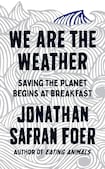
When Jonathan Safran Foer was on a book tour for his last nonfiction title he found himself often eating hamburgers. The book was Eating Animals, a treatise on the perils of factory farming. Yet there he was, doing exactly the thing he was campaigning against. Where animals were concerned, he knew the facts, he cared, but his actions didn’t reflect that.
His latest, We Are The Weather, plays on this hypocrisy. The vegan theme persists, but the lens turns towards the “single biggest threat to human survival”, climate change.
When it comes to the welfare of the planet, most of us know and care, but still refuse to act. A two-thirds vegan diet could cut our CO2 emissions enough to potentially save our home and way of life. Two-thirds, in practical terms, means no animal products before dinner time.
But, as the book acknowledges, this concept is as hard to believe as it is to enact. “My beautiful home is disappearing.” “I can save it by refusing a drop of milk.” “A” does not easily lead to “B”. And cutting through the equation is also “C”: the idea that the home will disappear eventually; it can’t be saved; ours is a story where everyone dies in the end.
The book begins with an end. The first page tells of “the oldest suicide note” known to man. Suicide permeates throughout: the suicide of climate activist David Buckel; the suicide of Foer’s own grandfather; and a striking image of the last humans on a doomsday emigration to another planet, looking back in regret.
“Imagine […] looking through a thick pane of protective glass and realising that our home was a masterpiece,” Foer invites.
He likens it to the experience of Kevin Hines, a man who survived a suicidal jump from the Golden Gate Bridge. “If we were to lose our planet perhaps each of us would think, as Hines did, watching the bridge recede as he fell, ‘what have I done’?”
Metaphors
They’re powerful images. This book is made of the likes. Suicide is not the only recurring motif – there’s space travel, molecular science, his grandmother lying in her death bed.
But what Foer does best is push metaphors until they move. Watch how that “suicide” idea shifts. By the end of the first chapter we have learnt that “it remains unknown whether the author of the first suicide note even killed himself”.
When we read the first line another suicide note [the one Foer’s grandfather wrote to his grandmother] we “could also be [reading] the beginning of a Valentine’s card”.
“A suicide note resembles nothing more closely than its opposite,” the first chapter concludes.
The book begins with an end, but it goes on. Its mission, it seems, is to unravel that end, so that life can happen instead.
The experience of reading this book allows us to see more fully what is before our eyes. It tries, simultaneously, to bring us out of the present moment and back into it.
When writing, Foer often passed a document in NYU library, called “In Event of Moon Disaster”. It’s a speech that was prepared in case the astronauts on Apollo 11 had ended up stranded on the moon. Imagining a reality where that speech was needed seems horrific. Yet we live, now, in an alternative future to the one it invokes.
What if we could read an “In the Event of Catastrophic Climate Change” speech now, Foer asks. Would this evidence help us understand the unprecedented environmental horror on our doorstep? “Would we believe what we understood?”
Threefold
The purpose of this book is threefold. First: to help us understand. Second: to help us believe. But it will have failed if it doesn’t achieve the third: to move us to act.
I was certainly moved by this book. It was late one night when I finished reading it. Incidentally, it was my birthday, and also (according to Google Doodle) the date on which “autumn season” began.
The next morning I woke to see yellow leaves scattered on the ground. I was a year older. Rain was falling. A blur of silver dashes moved before my eyes. It was beautiful. It was planet Earth.
A wave of sadness came over me. It was like sitting with a friend who I love but who has terminal cancer. But the important question was not: did I know, or did I care, but since it was breakfast time would I have tea without milk?
A simple question. Why did it feel like such a tall order?









